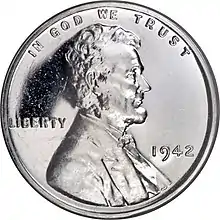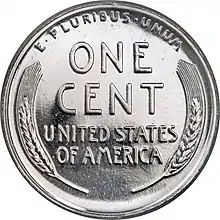United States | |
| Value | $0.01 U.S. dollars |
|---|---|
| Diameter | 19.05 mm |
| Edge | Plain |
| Years of minting | 1942 |
| Obverse | |
.jpg.webp) | |
| Design | Bust from the Colombian 2 centavo coin |
| Designer | Unknown |
| Design date | Unknown (original), 1942 (modified) |
 | |
| Design | Abraham Lincoln |
| Designer | Victor D. Brenner |
| Design date | 1909 |
| Reverse | |
.jpg.webp) | |
| Design | Wreath |
| Designer | Unknown |
| Design date | Unknown |
 | |
| Design | Wheat heads |
| Designer | Victor D. Brenner |
| Design date | 1909 |
The 1942 experimental cents were pattern coins struck by the United States Mint to test alternative compositions for the penny.
History
After the outbreak of World War II, the demand for copper rose as it was used in ammunition and other military equipment. The US Mint researched ways to reduce or eliminate the usage of copper in cent production. The mint struck pattern coins in various metals, using the obverse design of the Colombian two centavo coin.[1] Dies were sent to various companies to test possible non-metal compositions. Patterns were also struck with modified rim Lincoln cent dies.[2]
One of the compositions tested, zinc-coated steel, was chosen for the 1943 cent.[3]
Compositions
Colombian patterns
| Composition | Catalog number | Produced by | Notes |
|---|---|---|---|
| Bronze | J2051/P2073 | United States Mint | |
| Brass | J2052 | United States Mint | |
| Zinc | J2053 | United States Mint | |
| Zinc-coated steel | J2054/P2074 | United States Mint | This composition was chosen for the 1943 cent |
| Manganese | J2055/P2075 | United States Mint | |
| White metal | J2056 | United States Mint | |
| Aluminum | J2057/P2076 | United States Mint | |
| Lead | J2058 | United States Mint | |
| Bakelite | J2067/P4001 | Bakelite Corporation | |
| Transparent amber plastic | J2065/P4005 | Unknown | |
| Hard rubber | J2068/P4010 | Unknown | |
| Lead grey plastic | J2061/P4015 | Unknown | |
| Fibrous black plastic | J2059/P4020 | Unknown | |
| Light tan plastic | J2063/P4025 | Unknown | |
| Dark tan plastic | J2063/P4030 | Unknown | |
| Brown plastic | J2060/P4035 | Unknown | |
| J2070 | Auburn Button Works | Mirrored image, struck from hub dies | |
| Brass-colored plastic | J2064/P4040 | Unknown | |
| Red-brown plastic | J2062/P4045 | Unknown | Coin alignment |
| J2062/P4050 | Medal alignment | ||
| Rust-colored plastic | J2062/P4053 | Durez Plastics and Chemicals | |
| Red fibrous material | J2066 | Unknown | |
| Tempered glass | J2069 | Blue Ridge Glass Company |
Lincoln patterns
| Composition | Catalog number | Produced by | Notes |
|---|---|---|---|
| Aluminum | J2079 | United States Mint | Struck with standard proof dies |
| Zinc-coated steel | J2080 | United States Mint | Reported, but not confirmed |
| White metal | J2081 | United States Mint | Struck with modified rim Lincoln cent dies |
See also
References
- ↑ "J2051/P2073". uspatterns.com. Retrieved 2019-05-10.
- ↑ "J2081/P2077". uspatterns.com. Retrieved 2019-05-10.
- ↑ "1943 Steel Cent | Lincoln Steel Penny". 8 August 2009. Retrieved 2019-05-10.
This article is issued from Wikipedia. The text is licensed under Creative Commons - Attribution - Sharealike. Additional terms may apply for the media files.